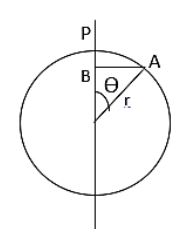
The radial component of centripetal acceleration at poles of earth is?
Where $R$ is the radius of earth, $\omega $ is the angular velocity of earth)
$\begin{align}
& A.zero \\
& B.R{{\omega }^{2}} \\
& C.{{R}^{2}}\omega \\
& D.\infty \\
\end{align}$
Answer
571.2k+ views
Hint: The equation of centripetal acceleration should be found first. Then the radial components can be substituted in that equation. As we know the y components will be zero at the poles because the angle being there is zero.
Complete step-by-step answer:
The centripetal acceleration is given by the formula,
${{a}_{c}}=\dfrac{{{v}^{2}}}{r}$
Where $v$ be the velocity of the rotation of earth and $r$be the radius of earth.
When we take radial components into account, the above equation becomes,
\[{{a}_{c}}=\dfrac{-{{v}^{2}}}{r}\times \sin \theta \]
And also we know that, the velocity can be written in the form of angular velocity as,
\[v=r\omega \]
Substituting this in the equation of centripetal acceleration will give,
\[{{a}_{c}}=\dfrac{-{{\left( r\omega \right)}^{2}}}{r}\sin \theta \]
Simplifying this will give,
\[{{a}_{c}}=-r{{\omega }^{2}}\sin \theta \]
As we know that the angle at the poles in the y component is found to be zero.
Substituting this in the equation will give,
\[\begin{align}
& {{a}_{c}}=\dfrac{-{{\left( r\omega \right)}^{2}}}{r}\sin 0 \\
& {{a}_{c}}=0 \\
\end{align}\]

So, the correct answer is “Option A”.
Note: Centripetal acceleration is defined as the characteristics of the motion of a particle which is travelling in a circular path. The acceleration has been directed radially towards the centre of the circular path. Centripetal forces are the reason for the centripetal accelerations. In the circular motion of earth around the Sun or any satellite having circular motion around any celestial body, the centripetal force is there as a result of the gravitational attraction between them. At the equator there is always a subtractive force present because of the gravity opposite to this, towards the centre. At the poles, as there is no distance from the centre of rotation, no centrifugal force is there.
Complete step-by-step answer:
The centripetal acceleration is given by the formula,
${{a}_{c}}=\dfrac{{{v}^{2}}}{r}$
Where $v$ be the velocity of the rotation of earth and $r$be the radius of earth.
When we take radial components into account, the above equation becomes,
\[{{a}_{c}}=\dfrac{-{{v}^{2}}}{r}\times \sin \theta \]
And also we know that, the velocity can be written in the form of angular velocity as,
\[v=r\omega \]
Substituting this in the equation of centripetal acceleration will give,
\[{{a}_{c}}=\dfrac{-{{\left( r\omega \right)}^{2}}}{r}\sin \theta \]
Simplifying this will give,
\[{{a}_{c}}=-r{{\omega }^{2}}\sin \theta \]
As we know that the angle at the poles in the y component is found to be zero.
Substituting this in the equation will give,
\[\begin{align}
& {{a}_{c}}=\dfrac{-{{\left( r\omega \right)}^{2}}}{r}\sin 0 \\
& {{a}_{c}}=0 \\
\end{align}\]

So, the correct answer is “Option A”.
Note: Centripetal acceleration is defined as the characteristics of the motion of a particle which is travelling in a circular path. The acceleration has been directed radially towards the centre of the circular path. Centripetal forces are the reason for the centripetal accelerations. In the circular motion of earth around the Sun or any satellite having circular motion around any celestial body, the centripetal force is there as a result of the gravitational attraction between them. At the equator there is always a subtractive force present because of the gravity opposite to this, towards the centre. At the poles, as there is no distance from the centre of rotation, no centrifugal force is there.
Recently Updated Pages
Why are manures considered better than fertilizers class 11 biology CBSE

Find the coordinates of the midpoint of the line segment class 11 maths CBSE

Distinguish between static friction limiting friction class 11 physics CBSE

The Chairman of the constituent Assembly was A Jawaharlal class 11 social science CBSE

The first National Commission on Labour NCL submitted class 11 social science CBSE

Number of all subshell of n + l 7 is A 4 B 5 C 6 D class 11 chemistry CBSE

Trending doubts
What is meant by exothermic and endothermic reactions class 11 chemistry CBSE

10 examples of friction in our daily life

One Metric ton is equal to kg A 10000 B 1000 C 100 class 11 physics CBSE

1 Quintal is equal to a 110 kg b 10 kg c 100kg d 1000 class 11 physics CBSE

Difference Between Prokaryotic Cells and Eukaryotic Cells

What are Quantum numbers Explain the quantum number class 11 chemistry CBSE




